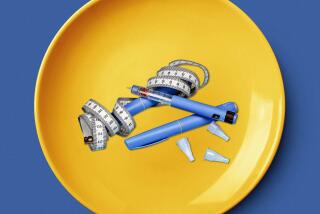Navy Seeks to Trim the Fat--by Diet : Health: It says overweight sailors are not fit for combat and is telling them to slim down or face discharge.
SAN DIEGO — Senior Chief Tom Cook would punch a wall when he got angry at his crew aboard a guided missile frigate. And then he would eat, and eat, and eat. Standing 6-feet-1, he saw his weight fluctuate between 205 and 260 pounds.
After 12 years of unswerving loyalty to the Navy, Cook was recently told to lose weight or lose his job. “I was very, very angry,” said Cook, 32. “I’m just fat, but I’m doing my job. Why get rid of me?”
The Navy says overweight sailors and officers are not fit for combat, and it is cracking down.
Today, in a last-ditch effort to rescue their careers, the best and the biggest sailors vie for a spot at one of four weight-loss clinics conducted by the Navy across the country, the largest of them at the Naval Alcohol Rehabilitation Center on the Miramar Naval Air Station here.
In the Navy, after a minimum of three warnings, anyone can be discharged if he remains overweight. An individual can also be prevented from transferring or advancing in rank because of his weight. For every dollar spent on an individual in treatment, it would cost $12 to replace that person, according to Navy estimates. The Navy says it costs $3,200 to put a person through the six-week program.
“It provides more productive man-hours, I feel, than any other program in the Navy today,” because it saves personnel from being discharged, said Capt. Ronald B. Lewis, commanding officer of the Miramar center, which treats 192 alcoholics, drug abusers and overeaters. About a quarter of those patients are usually overeaters.
The Navy considers any man overweight if he has more than 22% body fat; for a woman, the level is 30%. Last year, the Navy tried to help about 26,000 enlisted men and women, or 4% of its personnel, lose weight. Almost 900 were treated in residential programs. Officials declined to say how many were discharged because of their weight. But the Navy estimates that about 10% of its 614,598 men and women are overweight.
In the Miramar program, the average person who attends is 50 to 100 pounds overweight. They are mostly people who have tried, without lasting success, everything from diuretics to laxatives, from fasting to purging. Most have spent many years in the military, and for them, success means staying in the Navy. Of those who enroll in the Miramar program, about 70% succeed in keeping their weight down, according to one-year follow-up surveys.
Since 1984, all Navy personnel are measured about every six months for fat and put through an hourlong “physical readiness” test that includes a 1 1/2-mile run, push-ups and sit-ups. Miramar is open only to supervisory officers, or second class petty officers and above. After investing what can add up to millions of dollars in training, the Navy is reluctant to discharge an individual because of his weight, said Lt. Cmdr. Jim Blunt, an administrator involved with the program. But the Navy will enroll only those considered valuable and those who want to continue their service for several more years. “The Navy is not interested in investing six weeks treatment in someone who is going to be a poor sailor,” Blunt said.
To the dismay of commanding officers who send personnel to Miramar’s weight-loss program, many do not return dramatically slimmer than when they left.
“It’s not our intention to melt the weight off because it won’t work and the weight will come right back. We try to have a more long-term solution,” Blunt said.
Many arrive at Miramar calling it a “fat farm,” figuring they will be placed on strict diets and run through a treadmill of rigorous exercise. They are usually surprised to learn they are allowed to eat whatever they want.
“Nothing stops me from going to chow hall and pigging out,” said Chief Marc Rioux, in his final week at Miramar. “When I first got here, I thought this was asinine. How the hell would anyone lose weight with three meals a day? I thought they would give me a strict diet and run your butt off. And then I realized this place is working on your mind. I found myself asking for less and less food--and I was getting full.”
Blunt and a staff of 22 counselors hope to help the individual alter his or her habits and outlook as they would any substance abuser. They believe the chronic overeater uses food just as an alcoholic drinks or a drug user takes dope. Each abuser, they say, has a disease over which they have little control. So the weight program is modeled after Alcohol Anonymous and Narcotics Anonymous. And to the surprise of some, alcoholics, drug users and overeaters are placed in one program at Miramar.
“They get the opportunity to re-enter their disease three times every day. Alcoholics put the plug in the jug and that’s it,” said Blunt, a former overeater. “We have to take the tiger out of the cage and pet it three times a day.”
For several years, the Navy, Army and Air Force have tried to tackle the problem of unhealthy weight gain. The military, officials say, has been influenced by the fitness awareness trend sweeping the nation. Doctors warn that roughly 33 million Americans are so overweight that they are at high risk for a range of life-threatening conditions, such as high blood pressure, heart disease, diabetes and cancer.
While some in the Navy say they’ve had a life-long problem with overeating, others can pinpoint the time in their life when eating became a salve for jangled emotions. But for all participants, the program means confronting their past and how they cope with emotions.
Chief Rioux, a hospital corpsman now stationed in Alaska, began binge eating almost constantly after he returned from Vietnam, where he spent a year doing duty in the intensive care unit of a hospital ship.
“I had to put up with the pain and misery of caring for these young kids and knowing they were going to die,” said Rioux. “I kept swallowing down my feelings. And I swallowed a lot because I thought no one would care.”
Over the years, food became a buffer that separated Rioux from the world. He weighed 285 pounds at his heaviest and tests indicated that about 33% of his body was fat. Shopping for clothing became painfully embarrassing since stores seldom stock such large sizes.
“Eating to me was an outlet, like alcohol. It comforted me,” he said. “It relieved my anger and tension. Instead of sharing my emotions with my family or friends, I’d share it with my refrigerator or cupboard.”
Rioux and others say the real test comes when participants in the program leave Miramar, returning to the same jobs and tensions that drove them to eat in the first place.
“Sure, I’m scared,” Rioux said. “But this is something I’ll have to deal with the rest of my life.”


